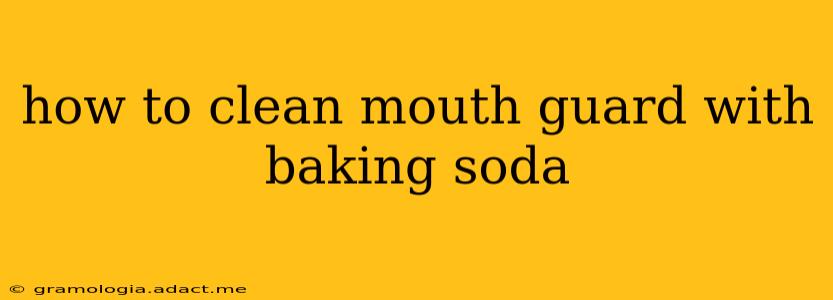Mouthguards are essential for protecting your teeth during sports or sleep, but keeping them clean is crucial for hygiene and longevity. While commercial mouthguard cleaners are available, a simple and effective method involves using baking soda. This guide explains how to clean your mouthguard with baking soda, addressing common concerns and offering additional tips for optimal oral health.
Why Use Baking Soda to Clean a Mouthguard?
Baking soda, or sodium bicarbonate, is a mild abrasive that effectively removes stains and odor-causing bacteria. Its natural properties make it a safe and readily available alternative to harsh chemicals found in some commercial cleaners. It's also relatively inexpensive, making it a budget-friendly option for maintaining mouthguard hygiene.
How to Clean Your Mouthguard with Baking Soda: A Step-by-Step Guide
Materials You'll Need:
- Your mouthguard
- Baking soda
- Water
- Soft-bristled toothbrush (old toothbrush works great!)
- Bowl or container
Instructions:
- Rinse your mouthguard: Begin by rinsing your mouthguard under cool running water to remove loose debris and saliva.
- Prepare the baking soda solution: In your bowl, mix a small amount of baking soda (about a teaspoon) with enough water to create a paste. The consistency should be similar to toothpaste.
- Apply the paste: Using your toothbrush, gently apply the baking soda paste to all surfaces of your mouthguard. Pay special attention to areas where staining or odor is most noticeable.
- Scrub gently: Use gentle, circular motions to scrub the paste into the mouthguard. Avoid using excessive force, as this could damage the material.
- Rinse thoroughly: Once you've scrubbed the entire mouthguard, rinse it thoroughly under cool running water until all traces of the baking soda paste are removed.
- Air dry: Allow your mouthguard to air dry completely before storing it in its case. Avoid using a towel, as this can introduce bacteria.
How Often Should You Clean Your Mouthguard with Baking Soda?
Ideally, you should clean your mouthguard with baking soda at least once a day, especially after use. If you wear your mouthguard frequently or engage in strenuous activities that cause excessive sweating, more frequent cleaning may be necessary.
Can Baking Soda Damage My Mouthguard?
Baking soda is generally safe for most mouthguard materials, but it's crucial to use it gently. Avoid scrubbing too aggressively, as this could scratch or damage the surface. If your mouthguard is made of a particularly delicate material, consider using a less abrasive cleaning method.
What if My Mouthguard Still Smells Bad After Cleaning with Baking Soda?
Persistent bad odor could indicate a build-up of bacteria that baking soda alone can't remove. In this case, you might consider soaking your mouthguard in a solution of diluted mouthwash or a specialized mouthguard cleaning solution. Ensure the solution is compatible with your mouthguard material.
Are there other ways to clean my mouthguard besides baking soda?
Yes! You can also use a denture cleaner (following the manufacturer's instructions), mild soap and water, or commercial mouthguard cleaning solutions. Choosing the best method depends on your mouthguard material and personal preference.
How do I store my mouthguard properly?
Proper storage is crucial to prevent bacterial growth and maintain the longevity of your mouthguard. Always store it in a clean, dry, and well-ventilated case when not in use.
By following these simple steps, you can keep your mouthguard clean, fresh, and ready to protect your teeth. Remember to always check your mouthguard for any signs of wear and tear and replace it when necessary. Maintaining good oral hygiene, including regular cleaning of your mouthguard, is essential for overall oral health.
